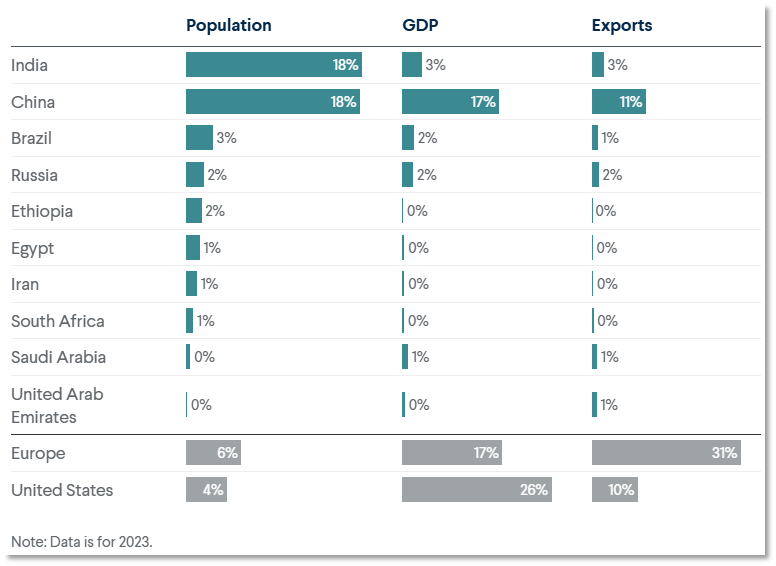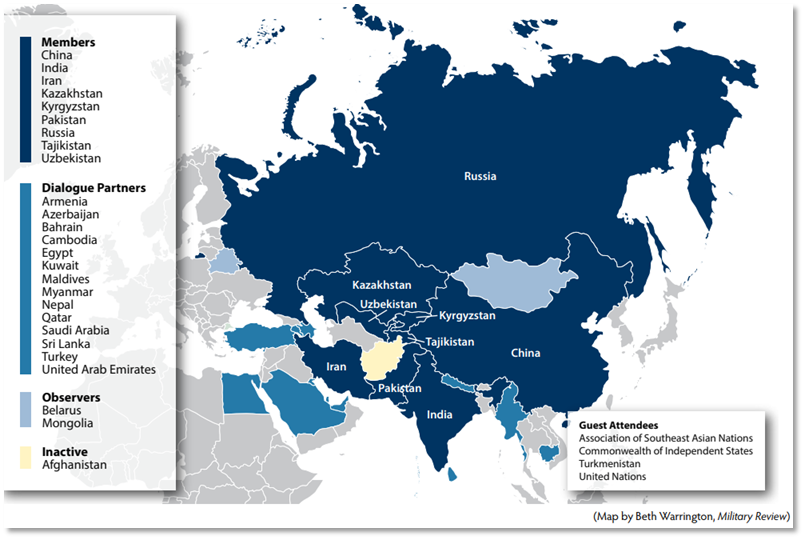Introduction
RMC’s White Paper “China-Cuba Relations: Recent Developments and Implications for U.S. National Security” in June 2023 detailed the diplomatic relations and economic cooperation between the People’s Republic of China (PRC) and Cuba. As the paper highlights, China’s investments in Cuba’s economy and infrastructure, military cooperation between the two (2) nations, and joint intelligence efforts present potential national security implications for the U.S. Over the past 18 months, China has continued investment and influence activities in Latin America and the Caribbean (LAC). The U.S. and its allies are concerned that the PRC is utilizing its economic leverage and relationships with nations in LAC to pursue geopolitical objectives, potentially expand its military capabilities, and bolster authoritarian regimes. The following White Paper highlights China’s growing influence in LAC by offering investment examples in Peru, Brazil, Mexico, and The Bahamas and associated U.S. national security concerns.
Belt and Road Initiative in Latin America and the Caribbean
Since taking power in 2013, Chinese President Xi Jinping has launched significant infrastructure projects worldwide as part of China’s “Belt and Road” Initiative (BRI). Xi’s vision of this “New Silk Road,” a reference to the original Silk Road during the westward expansion of China’s Han Dynasty, includes developing a significant network of railways, energy pipelines, highways, and streamlined border crossings westward and southward. At the same time, China’s leader seeks to establish a 21st Century Maritime Silk Road by investing in port development worldwide to accommodate increasing maritime trade. Many scholars and analysts recognize that the BRI’s effort to bolster “connectivity and communication” with states in Eurasia and Africa is a primary component of China’s strategy to advance its economic and political ties with the rest of the world.[1],[2]
A few years after launching the initiative, China’s President Xi referred to Latin America as a “natural extension of BRI.” LAC is home to valuable raw materials and agricultural goods, such as petroleum, soybeans, and lithium, and provides potential international shipping connectivity across the Pacific Ocean. As a result, the People’s Republic of China has increasingly engaged in trade, investment opportunities, and development projects with various nations in the region over the past 20 years. Furthermore, China looks to accrue soft power in LAC through educational and cultural exchanges and technological advancements.[1],[2],[3],[4]
From 2003 to 2022, Chinese foreign direct investment (FDI) totaled $187.5 billion in LAC. While data highlights the decreasing value of Chinese investment in LAC in recent years, Chinese interest in information and communication technology (ICT), renewable energy, and other emerging industries is increasing. In addition, China remains committed to infrastructure investments at ports throughout the region, including flooding LAC with crane exports. Chinese customs data reveals that crane exports to Latin America increased by 47% year-on-year from January to October 2024.[5],[6],[7]
Experts studying malign Chinese influence worldwide remain concerned about Chinese technology corporations, such as Huawei and ZTE, exponentially capturing LAC’s telecommunications markets. Huawei’s success in LAC is attributed to leveraging China’s foreign policy and diplomatic ties, the company’s quality customer service, and building access networks at low cost or free of charge in remote, mountainous, and rural areas where developing telecommunications infrastructure is expensive. While Huawei equipment cannot be sold or imported in the U.S. as of November 2022 due to national security concerns, the company now works with every large mobile and internet service provider in LAC. Also, the company is rapidly developing LAC’s 5G infrastructure. Experts fear that long-term dependencies on 5G developed by Huawei could amplify the CCP’s surveillance initiatives and control over the region’s communications, infrastructure, and sensitive technology. Though China’s economic interests are the primary driver for its activities in LAC, some analysts indicate that the PRC also seeks to expand its political influence in the region to counterattack the U.S.’s containment of China’s rise. In addition, China looks for governmental support in LAC for its positions on Taiwan, human rights, internet governance, and other affairs.[8],[9],[10],[11]
Peru
In November 2024, China continued expanding its investments and influence in Peru. From 15 to 16 November, Chinese President Xi Jinping, U.S. President Joe Biden, and leaders worldwide attended the 2024 Asia-Pacific Economic Cooperation (APEC) Leaders’ Summit in Lima. During the two-day summit, China and Peru updated their free trade agreement (FTA), which was initially signed in 2009. While the two (2) countries engaged in almost $36 billion in bilateral trade last year, Peru’s foreign minister indicated that the updated agreement would increase commerce by at least 50% between the nations. Earlier in November, China and Peru also agreed to a memorandum of understanding to increase bilateral cooperation on food security, food product regulation, and education.[12],[13]
China has significant mining and infrastructure projects in Peru, including the $3.6 billion Port of Chancay. The Chinese-funded megaport inaugurated on 15 November 2024 anticipates decreasing trans-Pacific transit times and logistics costs. Furthermore, the port is the first location in South America with the capacity to host carrier ships too large to fit through the Panama Canal. According to open-source reports, Shanghai Zhenhua Heavy Industries supplies the port’s automated cargo cranes, while China-based shipping company Cosco will operate the port exclusively. Analysts highlight that the Port of Chancay’s location could significantly impact supply chains. For example, Peru is South America’s second-largest producer of raw copper, a critical resource for manufacturing electronic and clean-energy technologies. China has invested $11.4 billion in the Peruvian mining sector, where most resources are devoted to ensuring access to copper.[12],[14]
Some security experts, including General Laura Richardson, the former Commander of U.S. Southern Command, warn that the Port of Chancay presents potential security risks to the Homeland. According to General Richardson, the port could be a dual-use facility for China’s Navy. While China states the project is motivated by commercial interests, the U.S. remains concerned that the port could enhance China’s military capabilities due to its size, depth, and strategic location.[14],[15]
Brazil
In November 2024, China and Brazil took significant steps in strengthening economic ties. Following the G20 Leaders’ Summit hosted in Brazil, that country’s President Luiz Inácio Lula da Silva hosted Xi Jinping for a state visit. On 20 November, China and Brazil signed 37 agreements on trade, technology, and the environment. While Brazil declined to join China’s BRI, Brazil “recognized the relevance” of the BRI in one (1) of the agreements and looks to pursue smaller bilateral deals with China. The package of 37 agreements also included a deal between China Development Bank and Brazil’s National Bank for Economic and Social Development (BNDES). China Development Bank loaned BNDES an equivalent of $690 million USD (¥5 billion) to support a variety of projects and expand alternatives to the U.S. dollar.[12],[16],[17]
The idea of reducing reliance on the American dollar is also a priority of the Brazil, Russia, India, China, and South Africa (BRICS) economic coalition. In 2015, the BRICS coalition established the New Development Bank. The newly-founded bank represents an alternative to Western-backed initiatives such as the International Monetary Fund and World Bank. During President Lula’s visit to China in April 2023, former Brazilian President Dilma Rousseff was sworn in as head of the New Development Bank. According to Rousseff, the New Development Bank has allocated about $6.1 billion to Brazil since its inception to December 2023, financing 21 projects.[18],[19],[20]
The relationship between China and Brazil is primarily economic, although the two (2) nations have engaged in various military cooperation agreements since mid-2000. Chinese companies have invested about $71 billion in Brazil from 2007 to 2023, more than any other nation in Latin America. In addition to concerns surrounding China’s increasing economic presence, open-source research analysis highlights potential risks associated with China’s satellite cooperation with Brazil. From 1984 to 2022, the two (2) nations signed 24 bilateral diplomatic agreements formalizing cooperation in the satellite sector. Furthermore, since China launched the China-Brazil Earth Research Satellite program’s first collaboratively developed satellite in 1999, the two (2) countries have worked together to launch six (6) satellites and seek to launch a seventh in early 2025. According to some U.S. national security experts, space facilities accessible to China in the region could potentially be utilized to intercept data transmitted by Western satellites. Furthermore, space facilities in the Western Hemisphere could potentially offer China telemetry or communication in support of kinetic attacks.[21],[22],[23]
Mexico
On 14 February 1972, Mexico and China established diplomatic and trade relations. Chinese direct investment in Mexico began in the late 1990s and accelerated in the 2010s as part of China’s global economic strategy. China targets Mexico’s manufacturing sector, capitalizing on the nation’s proximity to the U.S., skilled labor, and tariff-free access to North American markets through the United States-Mexico-Canada Agreement (USMCA). China also benefits from Mexico’s strategic position along key North American trade routes. However, many Mexican citizens view the PRC as a competitor, since both China and Mexico are established manufacturing exporters. Therefore, Mexico has not signed China’s BRI and is not a participant in the Asia Infrastructure Investment Bank (AIIB). However, China’s investments in Mexico, particularly in infrastructure and manufacturing, align with some BRI goals. These investments bolster Chinese companies’ supply chain resilience, reduce costs, and mitigate geopolitical risks.[24],[25],[26],[27],[28]
Some experts indicate that China’s growing economic influence in Mexico poses significant challenges to U.S. regional dominance, domestic manufacturing resilience, and economic security. For example, the proximity of Chinese-funded manufacturing operations to the U.S., particularly in industries such as computer equipment and electronics, raises critical national security risks. Open-source reports highlight that factories producing semiconductors or telecommunications components near the U.S. border could enable covert surveillance, data theft, or the insertion of compromised technology into critical infrastructure. These fears are amplified when such operations involve components used in U.S. defense systems, cloud computing, or smart technologies integral to national infrastructure. Furthermore, integrating Chinese companies into North American supply chains risks creating dependencies that Beijing could exploit during geopolitical conflicts, disrupting essential goods or imposing economic leverage. China’s strategic investments in Mexico may also diminish the effectiveness of U.S. sanctions and trade policies by providing Beijing with alternative economic footholds in the region.[29],[30],[31]
The Bahamas
China and The Bahamas established formal relations on 23 May 1997. Trade between China and The Bahamas, plus five (5) other Caribbean countries, has grown steadily over the past few decades. In 2022, China’s exports to The Bahamas totaled approximately $405 million, whereas Bahamian exports to China amounted to around $9 million. In addition, China has significantly invested in Bahamian infrastructure over the past 15 years, including a $30 million grant to develop a national stadium, preferential loans to construct a $3 billion megaport at Freeport, and $40 million to create a port off the island of Abaco. On 28 March 2024, the Bahamian Prime Minister endorsed China’s Global Development Initiative and reaffirmed the Bahamas’ commitment to the “One-China” policy.[32],[33],[34]
In 2021, the USNORTHCOM Commander testified before the U.S. Senate about concerns regarding China’s growing influence in the Caribbean, particularly in The Bahamas, as part of its broader strategy to undermine U.S. dominance. For example, while China’s investments have helped to bolster local economic recovery from Hurricane Dorian and the COVID-19 pandemic, U.S. officials warn that The Bahamas offers China a strategic foothold near critical U.S. infrastructure. In addition, Huawei has established a dominant presence in The Bahamas’ telecommunications market. In 2014, Bahamas Telecommunications Company (BTC) partnered with Huawei to upgrade the nation’s network to 4G LTE. Similarly, BTC’s main competitor, Aliv, relies heavily on Huawei for its infrastructure. Concerns about Huawei’s near monopoly in The Bahamas gained international attention in 2020, as an open-source report revealed evidence that Huawei equipment supplied to BTC had been used for cyberespionage targeting U.S. citizens.[35],[36],[37],[38],[39]
Conclusion
China is rapidly expanding its economic and political influence in LAC by serving as South America’s top trading partner and a significant foreign direct investment and lending provider in essential industries. As highlighted above, many American security experts remain concerned that Chinese investments in LAC’s critical infrastructure, such as deep-water ports and space facilities, pose potential national security threats to the U.S. As the PRC continues investing in critical infrastructure sectors in the region, some American analysts argue that the United States Congress, in coordination with the Executive Branch, should explore innovative trade, industrial, and development policies that bolster economic cooperation, address supply chain concerns, and enhance U.S. financial and nonfinancial assistance to LAC countries.[40],[41]
[1] Lei, Y. (2024, October 23). China–Latin America relations in the context of the Belt and Road Initiative. Wiley. Retrieved from https://onlinelibrary.wiley.com/doi/full/10.1111/dpr.12814.
[2] McBride, J., Berman, N., and Chatzky, A. (2023, February 2). China’s Massive Belt and Road Initiative. Council on Foreign Relations. Retrieved from https://www.cfr.org/backgrounder/chinas-massive-belt-and-road-initiative.
[3] U.S.-China Economic and Security Review Commission. (2021). China’s Influence in Latin America and the Caribbean. Retrieved from https://www.uscc.gov/sites/default/files/2021-11/Chapter_1_Section_2–Chinas_Influence_in_Latin_America_and_the_Caribbean.pdf.
[4] Congressional Research Service. (2023, June 23). China’s Engagement with Latin America and the Caribbean. Retrieved from https://crsreports.congress.gov/product/pdf/IF/IF10982.
[5] Pettus, E. L. (2023, October 5). The Expanding Leverage of the People’s Republic of China in Latin America: Implications for US National Security and Global Order. Indo-Pacific Affairs. Retrieved from https://www.airuniversity.af.edu/JIPA/Display/Article/3540614/the-expanding-leverage-of-the-peoples-republic-of-china-in-latin-america-implic/.
[6] Myers, M., Melguizo, A., and Wang, Y. (2024, January). Emerging Trends in Chinese Foreign Direct Investment in Latin America and the Caribbean. The Dialogue. Retrieved from https://thedialogue.org/wp-content/uploads/2024/12/Emerging-Trends-in-Chinese-Foreign-Direct-Investment-in-LAC-4.pdf.
[7] The Latin American Post Staff. (2024, December 02). China Expands Maritime Influence Across Latin America. Retrieved from https://latinamericanpost.com/business-and-finance/china-expands-maritime-influence-across-latin-america/.
[8] Delgado, J. (2023, March 07). China, 5G, and the Security Threat in Latin America. Diálogo. Retrieved from https://dialogo-americas.com/articles/china-5g-and-the-security-threat-in-latin-america/.
[9] Myers, M. (2023, August 25). China’s Increasing Involvement in Latin America and the Caribbean. Retrieved from https://www.nbr.org/publication/chinas-increasing-involvement-in-latin-america-and-the-caribbean/.
[10] Alvarado, P. D. (2024, April). Huawei’s Expansion in Latin America and the Caribbean: Views from the Region. United States Institute of Peace. Retrieved from https://www.usip.org/sites/default/files/2024-04/sr-529_huaweis-expansion-latin-america-caribbean-views-region.pdf.
[11] Berg, R.C. (2024, February 12). China and Russia engage Latin America and the Caribbean differently. Both threaten US interests. Atlantic Council. Retrieved from https://www.atlanticcouncil.org/in-depth-research-reports/issue-brief/china-and-russia-engage-latin-america-and-the-caribbean-differently-both-threaten-us-interests/.
[12] Holmes, S., and Huesa, J. (2024, November 26). China in Latin America: November 2024. Council on Foreign Relations. Retrieved from https://www.cfr.org/article/china-latin-america-november-2024.
[13] Aquino, M. (2024, November 11). Exclusive: Peru and China to sign strengthened free-trade agreement in Xi’s APEC visit. Reuters. Retrieved from https://www.reuters.com/world/peru-china-sign-strengthened-free-trade-agreement-xis-apec-visit-2024-11-08/.
[14] Stepherd, C., and Li, L. (2024, November 14). China opens huge port in Peru to extend its reach in Latin America. Stars and Stripes. Retrieved from https://www.stripes.com/theaters/americas/2024-11-14/china-peru-port-latin-america-foothold-warship-15849859.html.
[15] Stott, M. (2024, November 4). Chinese warships could use Peru’s big new port, US general warns. Financial Times. Retrieved from https://www.ft.com/content/f6589d13-6014-47d0-8cc5-e98a0b7ad0bc.
[16] Hughes, E. (2024, November 20). Brazil’s Lula welcomes China’s Xi for state visit as ties between countries strengthen. AP. Retrieved from https://apnews.com/article/brazil-china-xi-lula-b979f2f78530c917b37c47f97f24d96a.
[17] Paraguassu, L. (2024, November 20). Brazil development bank gets $690 million loan from China. Reuters. Retrieved from https://www.reuters.com/business/finance/brazil-development-bank-gets-690-million-loan-china-2024-11-20/.
[18] Associated Press. (2023, April 14). China’s Xi and Brazil’s Lula meet in Beijing to boost ties. NBC News. Retrieved from https://www.nbcnews.com/news/world/china-xi-jinping-brazil-lula-beijing-meeting-trading-partners-economy-rcna79732.
[19] Ferragamo, M. (2024, December 12). What Is the BRICS Group and Why Is It Expanding? Council on Foreign Relations. Retrieved from https://www.cfr.org/backgrounder/what-brics-group-and-why-it-expanding#chapter-title-0-2.
[20] New Development Bank. (2023, December 8). Brazil Receives USD 1.7 Billion from New Development Bank. Retrieved from https://www.ndb.int/news/brazil-receives-usd-1-7-billion-from-new-development-bank/.
[21] Soliz de Stange, A. (2023, June 14). China and Brazil’s Cooperation in the Satellite Sector: Implications for the United States? Journal of Indo-Pacific Affairs. Retrieved from https://www.airuniversity.af.edu/JIPA/Display/Article/3428204/china-and-brazils-cooperation-in-the-satellite-sector-implications-for-the-unit/.
[22] Chivvis, C.S. and Geaghan-Beinerm, B. (2023, December 13). Brazil in the Emerging World Order. Carnegie Endowment for International Peace. Retrieved from https://carnegieendowment.org/research/2023/12/brazil-in-the-emerging-world-order?lang=en.
[23] Ellis, R. E. (2024, February 16). China-Latin America Space Cooperation: An Overview. The Diplomat. Retrieved from https://thediplomat.com/2024/02/china-latin-america-space-cooperation-an-overview/.
[24] French, H.W. (2024, February 9). Mexico Is America’s Answer to China’s Belt and Road. Foreign Policy. Retrieved from https://foreignpolicy.com/2024/02/09/united-states-mexico-immigration-border-china-trade-bri/.
[25] Ellis, R.E. (2023, August 11). Mexico’s Engagement with China and Choices for its Future. US Army War College – Strategic Studies Institute. Retrieved from https://ssi.armywarcollege.edu/SSI-Media/Recent-Publications/Display/Article/3495410/mexicos-engagement-with-china-and-choices-for-its-future/.
[26] Reuters. (2023, December 5). China and Mexico officials vow to strengthen cooperation. Retrieved from https://www.reuters.com/world/china-mexico-officials-vow-strengthen-cooperation-2023-12-05/.
[27] Goodman, P.S. (2023, June 20). Why Chinese Companies Are Investing Billions in Mexico. The New York Times. Retrieved from https://www.nytimes.com/2023/02/03/business/china-mexico-trade.html.
[28] Ezrarti, M. (2024, October 26). Mexico Also Wants To Decouple From China. Forbes. Retrieved from https://www.forbes.com/sites/miltonezrati/2024/10/26/mexico-also-wants-to-decouple-from-china/.
[29] Kuttner, R. (2022, February 1). China: Epicenter of the Supply Chain Crisis. The American Prospect. Retrieved from https://prospect.org/economy/china-epicenter-of-the-supply-chain-crisis/.
[30] Escobado, R. (2024, December 18). U.S. begins to retaliate against China over hack of telecom networks. CBS News. Retrieved from https://www.cbsnews.com/news/u-s-retaliates-against-china-hack-telecom-networks/.
[31] Industrial Cyber. (2024, October 7). Chinese cyberattack reportedly compromised US broadband providers, possibly accessing federal court data. Retrieved from https://industrialcyber.co/threats-attacks/chinese-cyberattack-reportedly-compromised-us-broadband-providers-possibly-accessing-federal-court-data/.
[32] The Observatory of Economic Complexity (OEC). (2024, October). Bilateral Trade Profile: Chain & the Bahamas. Retrieved by https://oec.world/en/profile/bilateral-country/chn/partner/bhs.
[33] Griffin, P. J., and Danvers, W. (2021, November 15). A strategic challenge for the US: China and The Bahamas. The Hill. Retrieved from https://thehill.com/opinion/national-security/581017-a-strategic-challenge-for-the-us-china-and-the-bahamas/.
[34] Office of The Prime Minister, Commonwealth of The Bahamas. (2024, April 23). Prime Minister Philip Davis’s Remarks for the Official Visit of His Excellency Mao Weiming, Governor of Hunan Province, People’s Republic of China. Retrieved from https://opm.gov.bs/prime-minister-davis-governor-mao-weiming-official-visit-remarks/.
[35] Ward, J. (2023, October 11). US general warns of China’s plan for influence in Bahamas, region. The Nassau Guardian. Retrieved from https://www.thenassauguardian.com/home/us-general-warns-of-china-s-plan-for-influence-in-bahamas-region/article_af712826-0100-530f-8915-153a8a851903.html.
[36] Brown, O. (2024, August 10). China’s Ambassador Strengthening Ties Between The Bahamas And China. Bahamas Chronicle. Retrieved from https://bahamaschronicle.com/chinas-ambassador-strengthening-ties-between-the-bahamas-and-china/.
[37] The Nassau Guardian. (2023, October 12). A strategic challenge for the US: China and The Bahamas. Retrieved from https://www.thenassauguardian.com/opinion/a-strategic-challenge-for-the-us-china-and-the-bahamas/article_5077ad78-a3c0-5a7b-936f-f4bf279b5273.html
[38] Foreign Affairs Committee. (2022, November 14). China Regional Snapshot: The Caribbean. Retrieved from https://foreignaffairs.house.gov/china-snapshot-project-the-caribbean/#:~:text=China%20is%20a%20member%20of,Tobago%2C%20Guyana%2C%20and%20Suriname.
[39] Ellis, R.E. (2023, August 2). PRC Engagement in The Bahamas. US Army War College – Strategic Studies Institute. Retrieved from https://ssi.armywarcollege.edu/SSI-Media/Recent-Publications/Display/Article/3495418/prc-engagement-in-the-bahamas/.
[40] Roy, D. (2023, June 15). China’s Growing Influence in Latin America. Council on Foreign Relations. Retrieved from https://www.cfr.org/backgrounder/china-influence-latin-america-argentina-brazil-venezuela-security-energy-bri.
[41] Zhang, P. (2024, May). Pepe Zhang provides testimony to the US-China Economic and Security Review Commission. Atlantic Council. Retrieved from https://www.atlanticcouncil.org/commentary/testimony/pepe-zhang-provides-testimony-to-the-us-china-economic-and-security-review-commission/.
















 Figure 1
Figure 1 Figure 2
Figure 2